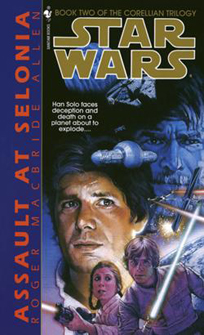“Assault at Selonia” (1995) has the same attributes as the first book in Roger MacBride Allen’s “Corellian Trilogy.” While it’s a brisk and easy read, not a lot happens here aside from a final-act space battle between the Bakuran Navy (representing the Republic) and an unclear enemy in the Corellian System.
On the downside, the same flaws from “Ambush at Corellia” are on display here. The typos and misspellings are still so abundant that I wonder if the book even had a line editor. On the plus side, the mystery – if slow to unfold — is intriguing. Thrackan Sal-Solo’s Human League is stirring up racial unrest between humans, Selonians and Drall in the Corellian System. But they seem far too incompetent (Han and Leia and Mara all escape captivity fairly easily, and it’s unclear why they were being held in the first place) to achieve the Imperial-style feat of blowing up two stars with an unknown superweapon. (Allen tells us the Empire does not exist at this point in the timeline, although books immediately before and after say otherwise.)
The characterization is mostly good, although Lando’s put-downs of C-3PO are so relentless that the ol’ smoothie is arguably more annoying than the droid. I wonder if Allen mixed up Lando with Han, who was more likely to rip Goldenrod in the films, whereas Lando basically ignored Threepio (and in the “Lando Calrissian Adventures,” the droid Vuffi Raa was his best friend).
And the treatment of Mara Jade is curious. Han is extremely suspicious of Mara, even flat-out wondering if she’s working for the bad guys, and Leia learns to trust Mara only after they team up to escape Human League captivity. The two women scale a wall, climb on a ledge and call the Jade’s Fire to their rescue via slave circuit, and Allen delivers near Zahn-level prose.
While it seems wrong that Han and Leia are only now learning to trust Mara, the incongruity with other books is not entirely the author’s fault, but rather an effect of the 1990s books being written out of order. The “Corellian Trilogy” takes place toward the end of the Bantam timeline, but it was written fairly early in the Bantam run, before many books that take place before it. While Mara is a peripheral character in the books between the “Thrawn Trilogy” and “Hand of Thrawn,” as she operates her own very successful shipping company, she tends to have unquestioned status as an ally when she does cross paths with our heroes. Basically, those books contradict what Allen established here, although a reader could legitimately ask why he thought Mara would be on the outs with Han and Leia a decade after she had proven herself – at least to Luke, whose judgment Han and Leia respect – in “The Last Command.”
At the risk of nitpicking, I’ll say it’s strange that the New Republic recruits the Bakuran Navy to take on the Corellian rebels in “Assault at Selonia” (although it does give Allen an excuse to pen a reunion between Luke and Gaeriel Captison, his almost-love-interest from “The Truce at Bakura”). Allen tells us that this conflict essentially caught the New Republic at a bad time, with military strength at a low ebb. But it must be REALLY low, because this is a much smaller conflict than the “Black Fleet Crisis” – where the massive Fifth Fleet needed to be augmented by an imaginary fleet projected by a Force-user – and indeed, it turns out that Bakura’s navy is all that’s needed. It doesn’t make sense that the New Republic taxes its citizens for a military but then has to ask a favor of a single member in order to fight its big battle of the moment. It’d be like the U.S. government asking California militia men to fight in Afghanistan while the federal troops stay at their various outposts.

And I’ll repeat my same criticism from the “Black Fleet Crisis” and “The New Rebellion”: Why aren’t the Jedi from Luke’s academy helping out? The only good thing about the “Jedi Academy Trilogy” was the creation of the Jedi academy, so why do so few of the subsequent Bantam books use those characters? If one argues that Luke’s Jedi are more philosophers than warriors, I’d contend that the Corellian conflict is a thought problem as much as a military conflict. Surely some of Luke’s Jedi could’ve tried some strategies among the downtrodden people on Corellia.
As the good guys scramble their forces in illogical fashion, it’s also unclear who exactly the bad guys are. It’s not that it’s poorly plotted. Allen is openly going for a sense of mystery and political intrigue, but for now it’s confusing. Thrackan Sal-Solo demands that the New Republic move all the non-humans off of Corellia or he’ll blow up more stars. But that’s an impossible ultimatum, if only from a logistical standpoint (especially since the Republic is – rightly – using its resources to evacuate the planets threatened by the starbuster). While Sal-Solo claims to seek Corellia’s independence from the New Republic, his actions (he takes credit for blowing up a star in an inhabited system at book’s end) pretty much guarantee a war. Arguably, he would’ve been better off gathering the local political support to have Corellia secede from the Republic. Of course, there’s a good reason why he wouldn’t do that: He doesn’t have enough local support.
This middle act feels a bit too much like it’s treading water (Anakin even uncovers the planetary repulsor on Drall just like he found the one on Corellia in the first book). But I suspect everything will tie together in the final book, “Showdown at Centerpoint,” and I’m looking forward to seeing if Allen can stick the landing.

